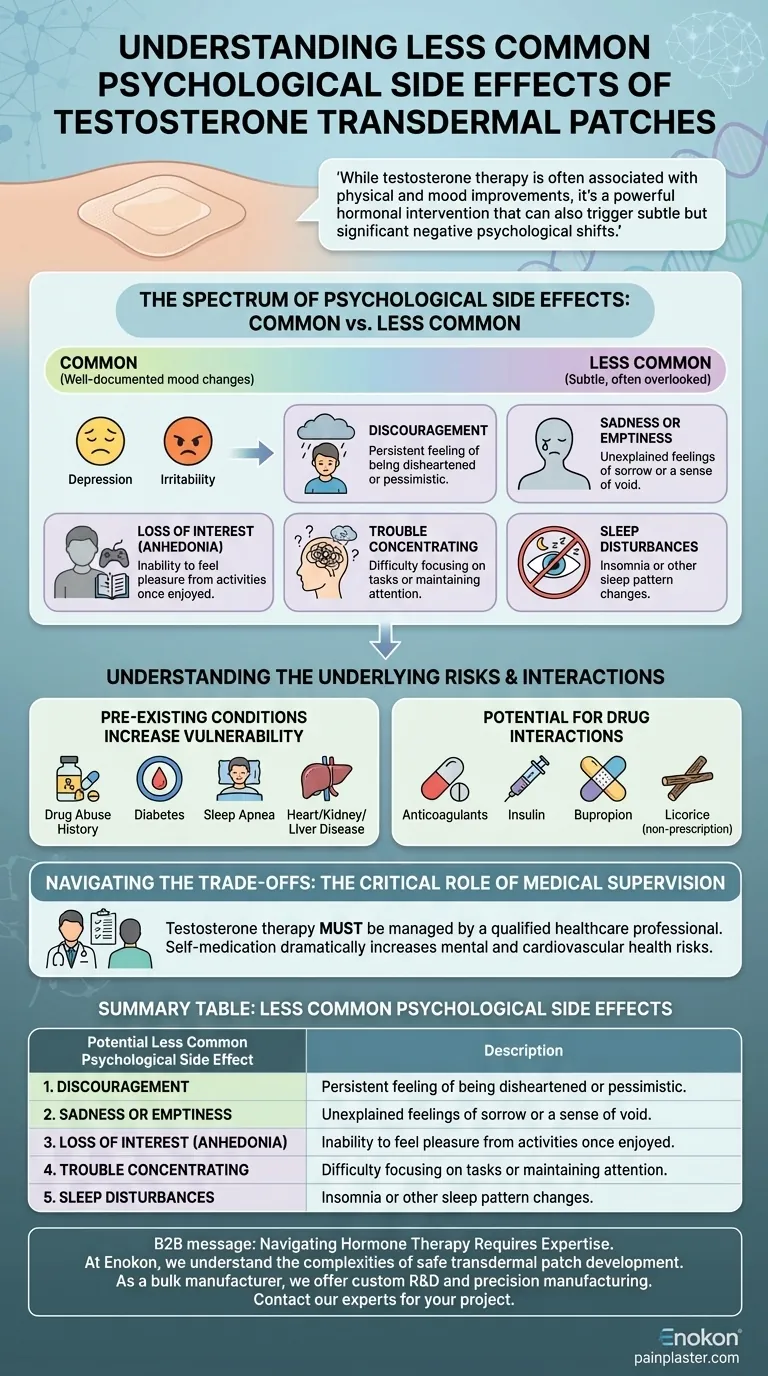Beyond the expected physical changes, using testosterone transdermal patches can introduce a range of less common psychological side effects. These can include feelings of discouragement, sadness or emptiness, irritability, a general loss of interest or pleasure, as well as trouble concentrating and sleeping.
While testosterone therapy is often associated with physical and mood improvements, it's a powerful hormonal intervention that can also trigger subtle but significant negative psychological shifts. Understanding the full spectrum of potential mental side effects is crucial for anyone considering or undergoing this treatment.

The Spectrum of Psychological Side Effects
The mental and emotional impact of testosterone therapy is not uniform. It ranges from common, well-documented mood changes to more nuanced symptoms that can be easily overlooked.
The Less Common Symptoms to Monitor
The side effects you asked about are often subtle and can be mistaken for general life stress. These include discouragement, a persistent feeling of being sad or empty, and a noticeable loss of interest or pleasure in activities you once enjoyed (anhedonia).
Additionally, users may experience trouble concentrating on tasks or find themselves struggling with insomnia or other sleep disturbances. While less frequent, these symptoms directly impact your quality of life and cognitive function.
How They Relate to Common Mood Changes
It's important to distinguish these from more "common" psychological side effects. The references list depression and irritability as known potential outcomes of testosterone patch use.
The less common effects, like "discouragement," can be seen as components or early warning signs of a more significant depressive episode. Therefore, they should never be dismissed.
Understanding the Underlying Risks
Psychological side effects do not occur in a vacuum. They are often linked to a person's overall health profile, other medications, and the body's systemic reaction to hormonal changes.
Pre-existing Conditions Increase Vulnerability
Your personal health history plays a significant role in your risk profile. Certain conditions can make you more susceptible to adverse effects from testosterone therapy.
These include a history of drug abuse, diabetes, sleep apnea, or pre-existing heart, kidney, or liver disease. The body is a complex system, and altering hormonal levels can exacerbate underlying issues, which may manifest as psychological distress.
Potential for Drug Interactions
Testosterone's effects can be altered by other substances. Combining testosterone patches with medications like anticoagulants (warfarin, rivaroxaban), insulin, or even bupropion is not typically recommended and requires careful medical supervision.
Even non-prescription substances like licorice can interact with the therapy and potentially increase the risk of side effects.
Navigating the Trade-offs of Therapy
The goal of testosterone replacement therapy is to improve well-being, but achieving this requires a clear understanding of the potential downsides and a commitment to medical oversight.
The Balance of Hormones and Mood
Introducing external testosterone is a significant intervention. While it can correct a deficiency, it can also disrupt the delicate hormonal balance that governs mood, cognition, and emotional regulation.
The emergence of psychological side effects is a signal that your body's system is not reacting as expected, and an adjustment may be needed.
The Critical Role of Medical Supervision
These risks underscore why testosterone therapy must be managed by a qualified healthcare professional. Self-medicating or misusing the patches dramatically increases the potential for serious mental and cardiovascular health problems.
A doctor can monitor your response, adjust your dosage, and determine if the psychological symptoms warrant discontinuing the therapy.
Making the Right Choice for Your Well-being
Your approach to testosterone therapy should be proactive and centered on open communication with your medical provider.
- If your primary focus is starting therapy safely: Have a thorough discussion with your doctor about your complete medical history, including any past or present mental health concerns, to establish a baseline before you begin.
- If your primary focus is monitoring your health while on therapy: Keep a simple journal of your mood and cognitive state, and report any negative changes—especially feelings of emptiness, irritability, or trouble concentrating—to your doctor immediately.
- If your primary focus is avoiding serious complications: Never combine testosterone patches with other medications without your doctor's explicit approval and be vigilant for physical warning signs like leg swelling or chest pain, which require immediate medical attention.
Ultimately, successful testosterone therapy relies on a vigilant partnership between you and your healthcare provider.
Summary Table:
| Potential Less Common Psychological Side Effect | Description |
|---|---|
| Discouragement | A persistent feeling of being disheartened or pessimistic. |
| Sadness or Emptiness | Unexplained feelings of sorrow or a sense of void. |
| Loss of Interest (Anhedonia) | Inability to feel pleasure from activities once enjoyed. |
| Trouble Concentrating | Difficulty focusing on tasks or maintaining attention. |
| Sleep Disturbances | Experiencing insomnia or other changes in sleep patterns. |
Navigating Hormone Therapy Requires Expertise
At Enokon, we understand that developing a safe and effective transdermal patch is complex. As a bulk manufacturer of reliable transdermal patches and pain plasters for healthcare and pharma distributors and brands, we provide more than just production.
Our technical expertise supports custom R&D and development, ensuring your products are formulated with precision and patient safety in mind. If you are a distributor or brand looking for a manufacturing partner committed to quality and safety, let's discuss your project.
Contact our experts today to explore how we can support your transdermal product development.
Visual Guide

Related Products
- Prostate Pain Kidney Health Care Patch for Men
- Far Infrared Heat Pain Relief Patches Transdermal Patches
- Medical Cooling Gel Patches for Fever Cooling Patches
- Menthol Gel Pain Relief Patch
- Icy Hot Menthol Medicine Pain Relief Patch
People Also Ask
- What should be done before undergoing an MRI while using testosterone patches? Remove it to prevent serious burns.
- What precautions should be taken when applying testosterone patches? Maximize Safety and Effectiveness
- What lifestyle factors should be considered when choosing between testosterone patches and injections? Find Your Best Fit
- What should be done if a testosterone patch falls off? A Guide to Maintaining Hormone Stability
- What should be done if a testosterone patch is missed or falls off? Follow these simple timing rules for safety and consistency.














